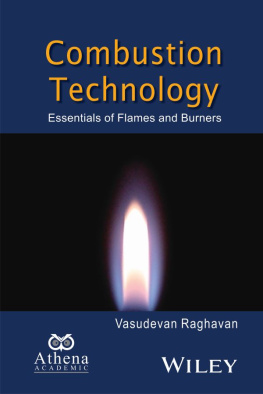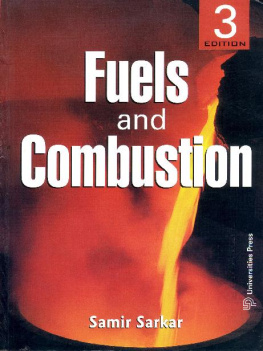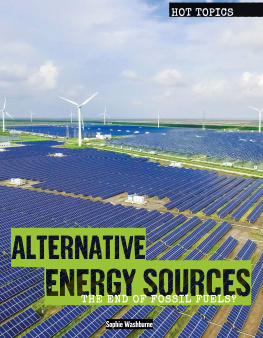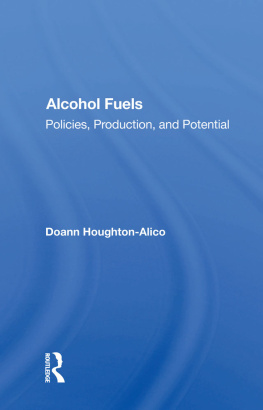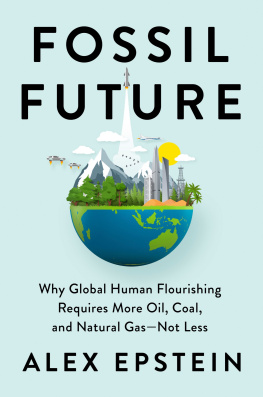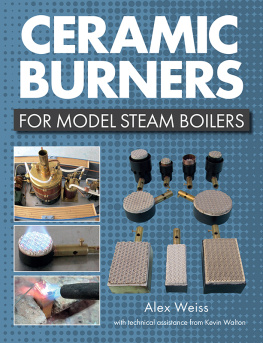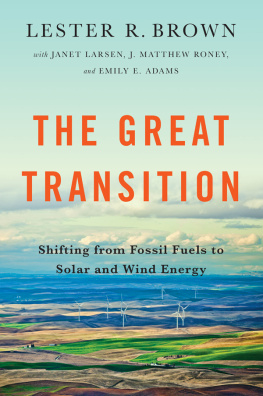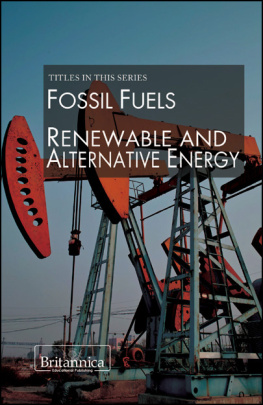
Table of Contents
List of Tables
- 1 Introduction
- 2 Review of Combustion Thermodynamics and Kinetics
- 3 Review of Combustion Phenomena
- 5 Burners for Liquid Fuels
- 6 Solid Fuel Systems
List of Illustrations
- 2 Review of Combustion Thermodynamics and Kinetics
- 3 Review of Combustion Phenomena
- 4 Burners for Gaseous Fuels
- 5 Burners for Liquid Fuels
- 6 Solid Fuel Systems
- 7 Alternative Fuels
Guide
Pages
Combustion Technology
Essentials of Flames and Burners
Vasudevan Raghavan
Associate Professor
Department of Mechanical Engineering
Indian Institute of Technology, Madras, INDIA
E-mail:
Combustion Technology: Essentials of Flames and Burners
Vasudevan Raghavan
Author, 2016
This Edition Published by
John Wiley & Sons Ltd.
The Atrium, Southern Gate
Chichester, West Sussex
PO19 8SQ United Kingdom
Tel : +44 (0)1243 779777
Fax : +44 (0)1243 775878
e-mail :
Web : www.wiley.com
For distribution in rest of the world other than the Indian sub-continent and Africa.
Under licence from:
Athena Academic Ltd.
Suite LP24700, Lower Ground Floor
145-157 St. John Street, London,
ECIV 4PW. United Kingdom
E-mail :
www.athenaacademic.com
ISBN : 978-11-1924-178-2
All rights reserved. No part of this publication may be reproduced, stored in a retrieval system, or transmitted in any form or by any means, electronic, mechanical, photocopying, recording or otherwise, except as permitted by the U.K. Copyright, Designs and Patents Act 1988, without the prior permission of the publisher.
Designations used by companies to distinguish their products are often claimed as trademarks. All brand names and product names used in this book are trade names, service marks, trademarks or registered trademarks of their respective owners. The publisher is not associated with any product or vendor mentioned in this book.
Library Congress Cataloging-in-Publication Data
A catalogue record for this book is available from the British Library
Disclaimer
The contents, sources, and the information provided by the authors in different chapters are the sole responsibility of the authors themselves, including the copyright issues. Editors and Publishers have no liabilities whatsoever towards these in any manner.
Preface
I am happy to bring out this book on Combustion Technology - Essentials of Flames and Burners. This book is mostly based on my lecture notes for post-graduate courses such as Fundamentals of Combustion and Combustion Technology that I teach at IIT Madras. This book is intended for senior under-graduate and beginning post-graduate students in Mechanical and allied engineering disciplines, combustion researchers, and practicing engineers working in the field of combustion. The book concentrates on the essential physical descriptions of the concepts using little mathematical support where required. This book is intended to provide a summary and review of the important concepts related to combustion science and a detailed discussion of the design aspects of different types of flames and burners.
The basic definitions relating to combustion phenomena, descriptions of various types of fuels and their important properties, different modes of combustion, associated emissions, and their consequences on the environment have been presented in the introductory . The contents of the first three chapters, therefore, form a comprehensive review of the fundamental aspects of the combustion science.
The next three chapters deal with the applications of combustion phenomena. A detailed discussion of the basic ideas and design features of burners for gaseous fuels is presented in . Finally, a chapter on alternative fuels has been included to bring out the need, characterization and performance of alternative fuels.
Review questions have been provided at the end of each chapter. These questions help the reader to evaluate their understanding of the important concepts covered in that chapter. Several standard text books have been cited in the chapters and are listed towards the end as suggested reading, to enable the readers to refer them when required.
I believe that this book can be a good quick reference for graduate and post-graduate students in their first level combustion courses, for combustion researchers for comprehending the research areas and for practicing engineers for recalling the necessary basics.
Vasudevan Raghavan
Acknowledgements
I express my heart-felt gratitude to Professor V. Babu, Department of Mechanical Engineering, IIT Madras, who has motivated me a lot to write this book. He was one of my PhD thesis advisors and has been my best well wisher and mentor since then. I undertook the task of writing this book only because of his constant urging. I was able to complete writing this book because of his support and encouragement. He has spent an enormous amount of time thoroughly reading the chapters and has made numerous suggestions - both technical and otherwise. As a result of this, the readability of this book has improved significantly. I do not have any words to thank him for his selfless efforts.
I express my sincere gratitude to Professor T. Sundararajan, Department of Mechanical Engineering, IIT Madras, who was my other PhD thesis advisor and teacher. He has been my well wisher always. I cannot forget the extra efforts he had put in to conduct many evening classes to explain many concepts related to combustion, in spite of his immense work schedule. He patiently taught me how to go about writing a technical work by bringing out all the associated physics.
My sincere gratitude to Professor George Gogos, University of Nebraska-Lincoln, USA, who was my mentor during my post-doctoral research career in his lab. I have been largely benefitted by the training he gave me on how to conduct rigorous research, thoroughly quantify the research findings and write concisely, and clearly.
I sincerely thank my co-worker and friend, Prof. Ali S. Rangwala, Department of Fire Protection Engineering, WPI, USA, for going through the chapters and for providing several useful comments to improve its readability.
My sincere thanks to Prof. U. S. P. Shet, who taught me combustion for the first time when I was a PhD scholar at IIT Madras. He also gave me many ideas on how to construct a lab-scale experiment to study laminar flames.
I thank Mr. Bhadraiah, my former M.Tech. student, Mr. Kohli, my former B.Tech. student and Mr. Sreenivasan, my former M.S. scholar, whose results have appeared in this book. My thanks are due to Dr. Shijin, my former PhD scholar, for simulating a few cases of diffusion flames. He helped me with the numerical results that appeared in the book. I also thank my PhD scholars, Mr. Akhilesh and Mr. Harish, for proof reading the chapters and indicating several corrections.
I sincerely acknowledge the financial support from Curriculum Development Cell of CCE, IIT Madras.
Vasudevan Raghavan
Introduction
In this introductory chapter, basic definitions relating to combustion phenomena are provided. A brief discussion of various types of fuels used in practical applications, along with their important characteristics, is presented next. Following this, the possible modes in which combustion can take place, the emissions generated during combustion of fuels and their consequences on environment are discussed.
Next page
